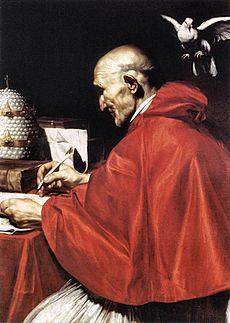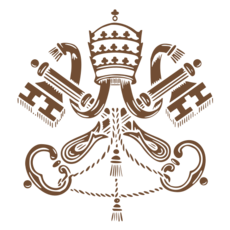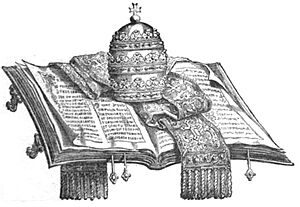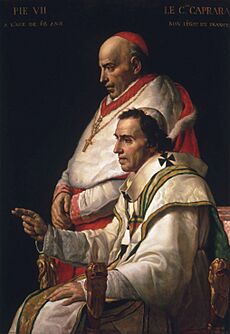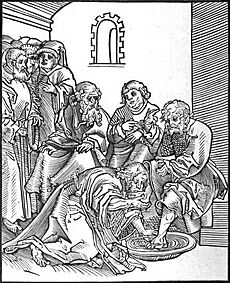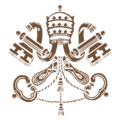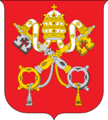Pope facts for kids
Quick facts for kids Bishop of RomePontifex maximus Pope |
|
|---|---|
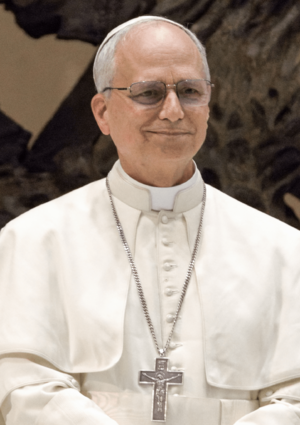
Pope Leo XIV in 2025
|
|
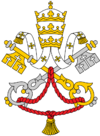
Coat of arms
|
|
| Location | |
| Country | Vatican City |
| Ecclesiastical province | Rome |
| Headquarters | Apostolic Palace, Vatican City |
| Information | |
| Denomination | Catholic Church |
| Established | 1st century |
| Cathedral | Archbasilica of Saint John Lateran |
| Governance | Holy See |
| Website | |
| vatican.va/holyfather | |
| Papal styles of Pope Leo XIV |
|
|---|---|
 |
|
| Reference style | His Holiness |
| Spoken style | Your Holiness |
| Religious style | Holy Father |
The pope is the bishop of Rome and the leader of the worldwide Catholic Church. He is also known as the supreme pontiff or Holy Father. From the 8th century until 1870, the pope was the ruler of the Papal States. Since 1929, he has been the head of the much smaller Vatican City state. Catholics believe the pope is the apostolic successor to Saint Peter. They believe Jesus gave Peter special authority, including the "Keys of Heaven". The current pope is Leo XIV, who was chosen on 8 May 2025.
The pope's office is called the papacy. His church area is known as the Holy See. The word see comes from a Latin word meaning 'seat' or 'chair'. This refers to the special chair the new pope sits on during his ceremony. The Holy See is like a country under international law. It is based in Vatican City, a tiny independent state inside Rome. Vatican City was created by the Lateran Treaty in 1929. This treaty made sure the Holy See could be independent. Many countries recognize the Holy See and have diplomatic ties with it.
Catholic tradition says that Saint Peter and Saint Paul started the church in Rome in the first century. The papacy is one of the oldest organizations in the world. It has played a big part in human history. In early times, popes helped spread Christianity. They also helped solve disagreements about beliefs. In the Middle Ages, popes were important leaders in Western Europe. They often helped settle arguments between kings. Today, popes work to unite different Christian groups. They also promote interfaith dialogue and do charitable work. They also speak up for human rights.
Over time, the papacy gained a lot of political power. This power sometimes rivaled that of kings. In recent centuries, the pope's political power has become smaller. Now, the office mainly focuses on religious matters. However, the pope's spiritual authority has grown stronger. In 1870, the idea of papal infallibility was declared. This means that on rare occasions, when the pope speaks officially about faith or morals, his words are considered without error. The pope is seen as one of the world's most powerful people. This is because of his influence on 1.3 billion Catholics. He also leads the world's largest non-government provider of education and health care.
Contents
- History of the Papacy
- Early Christian Mentions of the Pope
- Saint Peter and the Pope's Role
- The Pope as the New Eliakim
- How Popes Are Chosen
- What Are the Pope's Titles?
- Symbols and Clothes
- What Does the Pope Do?
- Different Views on the Papacy
- Antipopes
- Other Uses of the Title "Pope"
- Lengths of Papal Reigns
- Images for kids
- See also
History of the Papacy
The Pope's Title and Its Meaning
The word pope comes from a Greek word meaning 'father'. In early Christianity, this title was used for all bishops and senior church leaders. Later, it became mainly used for the bishop of Rome. This became official in the 11th century. The earliest record of the title 'pope' was for Heraclas, a church leader from Alexandria (232–248).
The Pope's Role in the Church
The Catholic Church teaches that the apostles, led by Saint Peter, were the first shepherds of the Church. Today, their successors, the bishops, continue this role. The bishop of Rome, the pope, is the head of all bishops. This is why he is called "supreme pontiff." The Catholic Church believes Jesus chose Peter to be the visible head of the Church. The pope is seen as Peter's successor. He leads the bishops just as Peter led the apostles.
Some historians debate if Peter was the first bishop of Rome. However, writings from Irenaeus (around 180 AD) say Peter "founded and organized" the Church in Rome. Other early writings also mention Peter's presence in Rome. For example, a letter from the Church of Rome (around 96 AD) mentions Peter and Paul as heroes. Many scholars agree that Peter died as a martyr in Rome.
In the first and second centuries, Christian communities might have had groups of leaders. Over time, single bishops became leaders in major cities. Rome's bishop gained importance. Early documents show the bishop of Rome had a special place in the Church. Even a leader from Antioch called the bishop of Rome "a first among equals."
Early Christianity (30–325 AD)
In the early Christian era, Rome and other cities were important Christian centers. The church in Rome was seen as very important. In 195 AD, Pope Victor I showed Rome's authority. He removed some churches from communion for celebrating Easter on a different date. The way the pope insisted on celebrating Easter on a Sunday is now the common practice.
From Nicaea to the East–West Split (325–1054 AD)
In 313 AD, the Edict of Milan allowed all religions in the Roman Empire to be free. In 325 AD, the First Council of Nicaea confirmed the belief in the Trinity. It also recognized the special roles of Rome, Alexandria, and Antioch. Popes like Liberius and Damasus I strongly defended the Trinitarian faith.
In 380 AD, Nicene Christianity became the official religion of the empire. In the Western Roman Empire, the bishops of Rome grew in power. After the Western Roman Empire fell, many tribes became Christian. Clovis I, king of the Franks, was an important ruler who allied with the papacy.
The Middle Ages
After the Western Roman Empire fell, the pope became a source of stability. Pope Gregory I (around 540–604 AD) led the church with strict rules. He helped shape the shift from ancient to medieval thinking. His writings included stories of miracles and angels.
Later popes were often influenced by the Byzantine emperor's representative in Italy. When the Byzantine Empire weakened, Pope Stephen II asked the Franks for help. Pepin the Short defeated the Lombards and gave land to the papacy. This land became the Papal States. When Pope Leo III crowned Charlemagne as emperor in 800 AD, it set a rule. In Western Europe, no one would be emperor without being crowned by a pope.
From 867 to 1049, the papacy faced many challenges. Popes were sometimes imprisoned or removed by force. Powerful families controlled who became pope. In 1049, Leo IX traveled across Europe. He worked to fix moral problems in the church, like buying and selling church positions. His travels helped restore the pope's good name in Northern Europe.
To fight corruption, church reform movements grew. The Abbey of Cluny was very important in this. This movement became stronger with Pope Gregory VII in 1073. He started the Gregorian Reform. This reform fought against corruption and tried to bring back church discipline. This included rules like clerical celibacy (priests not marrying).
In 1122, a conflict between popes and rulers, called the Investiture controversy, was settled. Pope Callixtus II decided that church leaders would choose clergy. Rulers would choose their own officials. Soon after, Pope Alexander III started reforms that led to canon law, which are church laws.
Starting in the 7th century, Islamic conquests took control of much of the southern Mediterranean. This was seen as a threat to Christianity. In 1095, the Byzantine emperor asked Pope Urban II for military help. Urban called for the First Crusade to help regain Christian lands, especially Jerusalem.
From the East–West Split to the Reformation (1054–1517 AD)
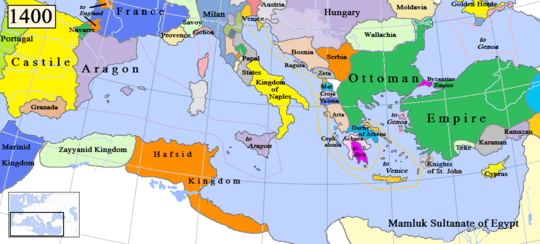
In 1054, the Eastern Orthodox Church and the Catholic Church officially split. This was called the East–West Schism. It was caused more by political events than by big differences in beliefs. Popes had upset Byzantine emperors by siding with Frankish kings.
In the Middle Ages, popes often struggled with kings for power. From 1309 to 1377, the pope lived in Avignon, France. This period was known for its challenges. During this time, the pope was seen as an ally of France. This made France's enemies, like England, unhappy.
The pope was believed to have the power to grant indulgences. These could reduce time spent in purgatory. People sometimes thought indulgences could be bought with money. Popes condemned these misunderstandings. However, they needed money and found it hard to control the abuses.
Popes also had disagreements with cardinals. Cardinals sometimes tried to say that church councils had more authority than the pope. This idea, called Conciliarism, grew in the 15th century. Its failure to be widely accepted was a factor in the Protestant Reformation.
Several Antipopes challenged the pope's authority. This was especially true during the Western Schism (1378–1417). This split ended when the Council of Constance chose one pope. The Eastern Church continued to decline with the Byzantine Empire. Twice, an Eastern emperor tried to reunite the Eastern Church with the West. But papal claims of superiority were a problem. In the 15th century, the Ottoman Empire captured Constantinople. This ended the Byzantine Empire.
From the Reformation to Today (1517 to Today)
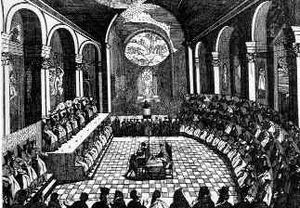
Protestant Reformers criticized the papacy. They saw it as corrupt. Popes started a Catholic Reformation (1560–1648). This addressed the challenges from the Protestant Reformation. It also brought internal reforms. Pope Paul III started the Council of Trent (1545–1563). This council defined church teachings. Its reforms helped the papacy succeed.
Popes gradually lost their political power to growing European nations. They then focused on spiritual matters. In 1870, the First Vatican Council declared the dogma of papal infallibility. This applies when the pope speaks officially about faith or morals. Later that year, Victor Emmanuel II of Italy took Rome from the pope. This completed the unification of Italy.
In 1929, the Lateran Treaty created Vatican City. This made it an independent city-state. It ensured the pope's independence from secular rule. In 1950, Pope Pius XII defined the Assumption of Mary as a dogma. This is the only time a pope has spoken infallibly since the doctrine was declared. The idea of St. Peter's special role continues to divide Eastern and Western churches. It also separates Protestants from Rome.
Early Christian Mentions of the Pope
Early Christian writers mentioned the authority of the bishops of Rome. These writings show that the pope was seen as an important figure. They also show the importance of following Rome's teachings. These references helped establish the idea of the pope's special role.
Cyprian of Carthage (around 210–258 AD) wrote about the bishop of Rome. In his Letter 55, he called Pope Cornelius the successor of St. Peter. He confirmed the pope's unique authority in the early Church.
Irenaeus of Lyons (around 130–202 AD) was an important Christian writer. In his work Against Heresies III, he listed early popes. This list goes from Saint Peter to Pope Eleutherius (174 to 189 AD).
Ignatius of Antioch (died around 108/140 AD) wrote about the church in Rome. In his Epistle to the Romans, he called it "the church that presides over love."
Augustine of Hippo (354–430 AD) also listed popes in his Letter 53. His list goes from Saint Peter to Siricius. He emphasized the clear line of succession from Peter.
Eusebius (around 260/265 – 339 AD) mentioned Linus as Saint Peter's successor. He also named Clement as the third bishop of Rome. Eusebius wrote that Clement worked with Saint Paul.
Tertullian (around 155 – 220 AD) wrote about the authority of the church in Rome. In his work The Prescription Against Heretics, he said Rome's church had the authority of the Apostles. This was because of its direct link to them. He also stated that Clement of Rome was ordained by Saint Peter.
Optatus, a bishop from Numidia (modern Algeria), wrote about the pope's role. In his book The Schism of the Donatists (367 AD), he discussed the bishop of Rome's importance. He said the pope helped keep the Church united.
Saint Peter and the Pope's Role
The Catholic Church teaches that bishops are the successors of the apostles. The bishop of Rome, the pope, is the successor of Saint Peter. The Bible texts that support Peter's special role include:
- Matthew 16: "I tell you, you are Peter, and on this rock I will build my church... I will give you the keys of the kingdom of heaven..."
- Luke 22: "Simon, Simon... I have prayed for you that your faith may not fail. And when you have turned again, strengthen your brothers."
- John 21: "Feed my sheep."
The keys on the Papal coats of arms represent the "keys of the kingdom of heaven." Some people argue that the "rock" Jesus speaks of is Jesus himself or Peter's faith. However, many scholars agree that "rock" refers to Peter himself.
The Pope as the New Eliakim
The Catholic Church also sees the pope as a new Eliakim. Eliakim was a figure in the Old Testament of the Bible. He managed the royal court and state affairs. The Bible says he had the key to the house of David, showing his authority.
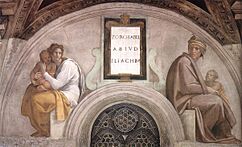
Both Matthew 16:18–19 and Isaiah 22:22 show Eliakim and Peter receiving keys. These keys symbolize power. Eliakim gets the power to close and open. Peter gets the power to bind and loose.
In Isaiah 22:23, Eliakim is compared to a peg. A peg provides support and stability. In Matthew 16:18, Peter is compared to a rock. Jesus says, "on this rock I will build my church."
How Popes Are Chosen
Election Process
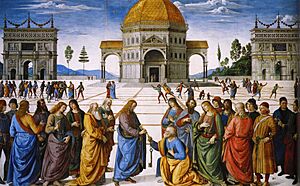
Originally, senior clergy in and near Rome chose the pope. In 1059, only cardinals could vote. By 1179, all cardinal electors had equal votes. Today, only cardinals under 80 years old can vote. The pope does not have to be a cardinal. Any baptized Catholic male can be elected. The last non-bishop elected was Gregory XVI in 1831. If a non-bishop is elected, he must become a bishop before the election is announced.
The Second Council of Lyon in 1274 set rules for papal elections. It said cardinals must meet within ten days of the pope's death. They must stay hidden until a new pope is chosen. This rule came after a three-year wait for a new pope in 1268. By the mid-16th century, the election process was similar to today's.
Since 1878, the pope's election happens in the Sistine Chapel. This secret meeting is called a "conclave". The word means "with a key," because cardinals are locked in until they elect a new pope. Three cardinals are chosen to collect votes from sick cardinals. Three count the votes, and three review the count. Cardinals write their choice on a ballot. They promise to vote for "one whom under God I think ought to be elected." Ballots are folded and placed on a plate, then into a chalice.
For the 2005 papal conclave, a special urn was used. The plate helps prevent multiple ballots. Before reading, ballots are counted while folded. If the number of ballots doesn't match the number of voters, they are burned, and a new vote is held. Otherwise, each ballot is read aloud. Balloting continues until someone gets a two-thirds majority.
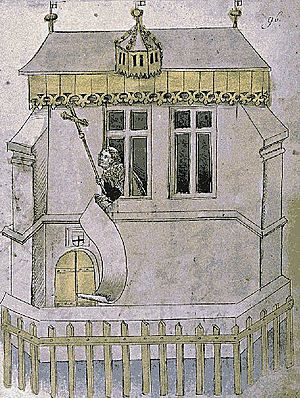
The senior cardinal then asks the elected man two questions. First, "Do you freely accept your election as supreme pontiff?" If he says "Accepto" (I accept), his reign begins. The cardinal then asks, "By what name shall you be called?" The new pope announces his chosen name.
The new pope goes to the "Room of Tears." There, three sizes of white papal clothes await him. After dressing, he returns to the Sistine Chapel. He receives the "Fisherman's Ring". He then takes a place of honor. The other cardinals offer their "obedience" and receive his blessing.
The results of each vote are announced to the world by smoke. After counting, the ballots are burned in a special stove. The smoke comes out of a chimney visible from Saint Peter's Square. If the vote is unsuccessful, a chemical compound is added to make black smoke (fumata nera). If a pope is elected, the ballots burn alone, making white smoke (fumata bianca). Since 2005, church bells also ring when a new pope is chosen.
Soon after, the senior cardinal announces from a balcony: Annuntio vobis gaudium magnum! Habemus Papam! ("I announce to you a great joy! We have a pope!"). He says the new pope's birth name and his chosen papal name.
Until 1978, the pope's election was followed by a papal coronation. This involved a grand procession to St. Peter's Basilica. The new pope was carried on a special throne called the sedia gestatoria. After a special Mass, he was crowned with the triregnum (papal tiara). He then gave the blessing Urbi et Orbi ("to the City [Rome] and to the World"). A traditional warning was given: "Thus passes worldly glory." Another reminder was "You will not see the years of Peter." This meant he would not reign as long as St. Peter, who led the church for 35 years. Today, the new pope celebrates a special Mass to begin his papacy. Many people, including leaders from other nations, attend.
For centuries, popes were mostly Italian. Before Pope John Paul II (from Poland) in 1978, the last non-Italian was Adrian VI (from the Netherlands) in 1522. John Paul II was followed by Benedict XVI (from Germany). Then came Francis (from Argentina), the first non-European in over 1200 years. The most recent election, of Pope Leo XIV (formerly Robert Francis Cardinal Prevost), continues this trend. He was born in the United States, became a citizen of Peru, and served there. He also spent many years in Italy and the Vatican.
Death of a Pope
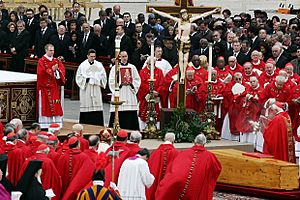
Rules for when a pope dies or resigns are in a 1996 document by Pope John Paul II. This period is called sede vacante ("vacant seat"). During this time, the College of Cardinals leads the Church and Vatican. They cannot make new rules for the Church. Any decision needing the pope's approval must wait for the new pope.
In recent centuries, it was traditional for the cardinal camerlengo to confirm a pope's death. He would gently tap the pope's head three times with a silver hammer, calling his birth name. This was not done for popes John Paul I and John Paul II. The cardinal camerlengo takes the Ring of the Fisherman and cuts it in two. The pope's seals are destroyed so they cannot be used again. His private apartment is sealed.
The pope's body lies in state for several days. Then it is buried in a church crypt. All popes who died in the 20th and 21st centuries are buried in St. Peter's Basilica. An exception is Pope Francis, who asked to be buried in the Basilica of St. Mary Major. A nine-day period of mourning follows the burial.
Resignation of a Pope
It is very rare for a pope to resign. The 1983 Code of Canon Law says a pope's resignation must be made freely and clearly. It does not need to be accepted by anyone. Benedict XVI resigned on 28 February 2013. He was the first pope to do so since Gregory XII in 1415.
What Are the Pope's Titles?
| Styles of The Pope |
|
|---|---|
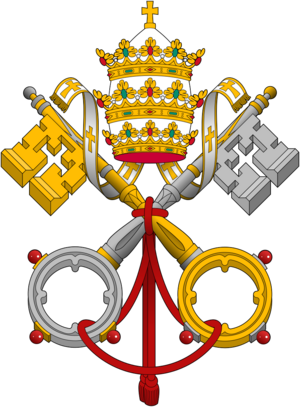 |
|
| Reference style | His Holiness |
| Spoken style | Your Holiness |
| Religious style | Holy Father |
| Posthumous style | See here |
Papal Name
Popes choose a new name when they are elected. This is called a papal name. After a new pope accepts his election, he is asked, "By what name shall you be called?" He chooses the name he will use. The senior cardinal then announces the new pope's birth name and his chosen papal name in Latin. It is common to translate the papal name into local languages. For example, the current pope is Papa Leo XIV in Latin, and Pope Leo XIV in English.
Official List of Titles
The official list of the pope's titles, found in the Annuario Pontificio, includes:
Bishop of Rome, Vicar of Jesus Christ, Successor of the Prince of the Apostles, Supreme Pontiff of the Universal Church, Patriarch of the West, Primate of Italy, Archbishop and Metropolitan of the Roman Province, Sovereign of the Vatican City State, Servant of the servants of God.
The most common title, "pope," is not on this official list. However, it is used in documents and signatures. For example, Paul VI signed as "Paulus PP. VI." "PP." might mean "papa" (pope) or "papa pontifex" (pope and pontiff).
The title "pope" was used for any bishop in the West in the early 3rd century. In the East, it was only for the bishop of Alexandria. From the 6th century, it became mainly used for the bishop of Rome. This was firmly in place by the 11th century.
Vicar of Jesus Christ
"Vicar of Jesus Christ" is an official title of the pope. It means he acts in Christ's place. This title shows his supreme leadership of the Church on Earth. It is believed this power was given to Saint Peter by Christ.
The first time this title was used for a bishop of Rome was in 495 AD for Gelasius I. In earlier centuries, other bishops also called themselves "vicars of Christ." Kings and judges sometimes used it too. Its use specifically for the pope became common in the 13th century.
This title is not only for the pope. All bishops are called "vicars and ambassadors of Christ." The difference is that other bishops are vicars for their local churches. The pope is vicar of Christ for the whole Church.
Supreme Pontiff
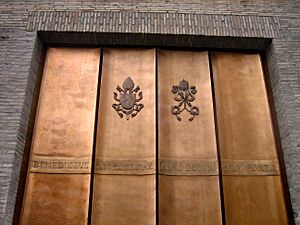
The word "pontiff" comes from a Latin word meaning "bridge builder." It was used for chief priests in ancient Rome. In Christian use, it referred to the High Priest of Israel. Later, it was used for any Christian bishop. Since the 11th century, it mainly refers to the bishop of Rome.
The Annuario Pontificio lists "Supreme Pontiff of the Universal Church" as an official title. "Pontifex Maximus" is similar in meaning. It is often seen on papal buildings, statues, and coins, usually shortened to "Pont. Max." or "P.M." Popes began using this title regularly in the 15th century.
Servant of the Servants of God
The title "servant of the servants of God" was used by other church leaders too. But Gregory the Great first used it widely as a papal title. He reportedly used it to teach humility to the patriarch of Constantinople. It became reserved for the pope in the 12th century. It is used in important papal documents.
Patriarch of the West
From 1863 to 2005, and again in 2024, the Annuario Pontificio included the title "patriarch of the West". This title was first used in 642 AD. It was only used sometimes. In 2006, the Vatican said it was removed to show a "historical and theological reality" and help with talks with other churches. The title means the pope's special link to the Latin Church. It was brought back in 2024, but the Vatican has not explained why.
Other Titles
Other common titles are "His Holiness" and "Holy Father." In Spanish and Italian, "Most Blessed Father" is often used. In medieval times, "the Apostolic Lord" was also used.
Pope's Signature
Pope Francis sometimes signs documents with just his name. Other times, he uses the traditional Latin signature with "PP." for "Pope." Popes with a number in their name usually put "PP." before the number, like "Leo PP. XIV."
Symbols and Clothes
- Ring of the Fisherman: A gold ring with a picture of St. Peter fishing. It has the pope's name around it.
- Umbraculum: A canopy or umbrella with red and gold stripes. It used to be carried above the pope in processions.
- Sedia gestatoria: A mobile throne carried by twelve footmen. It was accompanied by fans made of white ostrich feathers. Pope John Paul I stopped using the fans. Pope John Paul II stopped using the throne.
In heraldry, each pope has his own coat of arms. For centuries, these arms have had two crossed keys behind the shield. One key is silver, one is gold, tied with a red cord. Above them is a silver triregnum (papal tiara) with three gold crowns.
In the 21st century, popes have changed this tradition. In 2005, Pope Benedict XVI kept the crossed keys. But he replaced the tiara with a mitre (a bishop's hat) with three lines. He also added the pallium, an older symbol of papal authority. The coat of arms of the Holy See still includes the tiara. In 2013, Pope Francis kept the mitre but removed the pallium.
The flag of Vatican City is yellow and white. It has the arms of the Holy See on the white side. This flag was adopted in 1808. Even though Pope Benedict XVI changed his personal coat of arms, the tiara remains on the flag.
Papal Garments
Pope Pius V (1566–1572) is often given credit for the pope wearing white. He continued to wear the white clothes of his Dominican order after being elected. But the basic papal attire was white long before him. The earliest document describing it as white is from around 1274. Later books describe the pope wearing a red mantle, but a white cassock and stockings. Many old paintings show popes before Pius V wearing a white cassock.
What Does the Pope Do?
Pope's Authority
The pope's authority in the Catholic Church was officially defined in 1870 by the First Vatican Council. The council stated that:
- Saint Peter was chosen by Christ as the chief of all apostles. He was the visible head of the Church.
- Saint Peter has endless successors in his leadership role. The Roman Pontiff is Peter's successor.
- The Roman Pontiff has full and supreme power over the whole Church. This includes matters of faith, morals, discipline, and government.
- When the pope speaks officially about faith or morals, he is infallible. This means his definitions are unchangeable.
The Second Vatican Council (1964) also spoke about the pope's authority. It said bishops teach with the pope's approval. People should respect their teaching. They should also show special respect to the pope's teaching, even when he is not speaking infallibly. The council confirmed that the pope, as head of the bishops, has infallibility when he officially declares a doctrine of faith or morals.
Residence and Church Area
The pope's official church seat is the Archbasilica of Saint John Lateran. This is considered the cathedral of the Diocese of Rome.
The pope's official home is the Apostolic Palace. He also has a summer home at Castel Gandolfo.
The terms "Holy See" and "Apostolic See" refer to the pope's authority as bishop of Rome. His powers come from being the successor of Saint Peter. Rome has always been central to the Catholic Church. However, the pope does not have to live there. Wherever the pope lives, that is the central government of the Church. From 1309 to 1378, popes lived in Avignon, France.
Salary and Benefits
As of 2024, the pope's salary was €30,000 per month. However, Pope Francis, a Jesuit, chose not to take a salary. He donated the money to the poor.
The Catholic Church covers all the pope's expenses. This includes meals, housing, clothes, transport (like the Popemobile), security, and healthcare. The pope has free access to Vatican medical services.
If a pope retires, his monthly pension was €2,500 per month as of 2024.
Leading the Diocese of Rome
The pope is the bishop of Rome. But he lets the cardinal vicar handle most of the daily work. The cardinal vicar oversees the diocese's needs for the pope. The current cardinal vicar is Baldassare Reina.
Popes do pay attention to their diocese. For example, when Pope John XXIII announced the Second Vatican Council in 1959, he first thought about the Catholic Church in Rome. Then he looked at the whole world.
Political Role
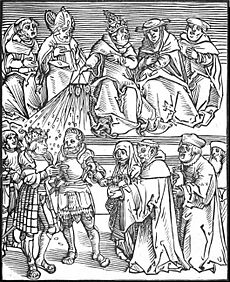
In the 4th century, as the Roman Empire became Christian, bishops did not have civil power. But as imperial power weakened in the 5th century, the pope became the senior civil official in Rome. Pope Leo I showed this when he met Attila in 452.
The pope's rule outside Rome began in 728 with the Donation of Sutri. In 754, the Frankish ruler Pippin the Younger gave land to the pope. This land formed the core of the Papal States.
In 800, Pope Leo III crowned Charlemagne as Roman emperor. This was a big step toward the Holy Roman Empire. From then on, popes claimed the right to crown the emperor. This right was last used in 1530. In 1804, Pius VII was at coronation of Napoleon I but did not crown him. The pope's rule over the Papal States ended in 1870.
Popes like Alexander VI and Julius II were powerful leaders. They used their power to increase the papacy's influence. This political power was clear during conflicts with emperors.
Popes used official documents called papal bulls, interdicts, and excommunication to show their power. For example, the bull Laudabiliter in 1155 allowed King Henry II of England to invade Ireland. In 1207, Innocent III put England under interdict. King John then made his kingdom a fiefdom to the pope.
The Bull Inter caetera in 1493 led to the Treaty of Tordesillas in 1494. This treaty divided the world into Spanish and Portuguese areas. The bull Regnans in Excelsis in 1570 removed Queen Elizabeth I of England from the Church. It said her subjects no longer had to obey her. The bull Inter gravissimas in 1582 created the Gregorian calendar.
In recent decades, the papacy has been less directly involved in politics. But popes still have much political influence. They have also acted as mediators. Pope John Paul II, from Poland, was seen as important in the fall of Communism in Eastern Europe. He also helped settle a conflict between Argentina and Chile. In the 21st century, Pope Francis helped improve relations between the United States and Cuba in 2015.
International Position
Under international law, a serving head of state has sovereign immunity. This means they cannot be sued in the courts of other countries. International law treats the Holy See like a state. It is different from Vatican City. The Holy See existed for centuries before Vatican City.
Many countries have diplomatic relations with the Holy See. Even countries without these relations join international organizations where the Holy See is a member.
The pope, as head of the Holy See, has head-of-state immunity. This means he is generally protected from lawsuits in foreign courts.
Different Views on the Papacy
The pope's claim to authority is disagreed with by other churches.
Orthodox, Anglican, and Old Catholic Churches
Other traditional Christian churches accept the idea of Apostolic succession. They accept, to some extent, the pope's claim to a special honor. But they generally do not accept the pope as Peter's successor in other ways. They see the pope's special honor as a result of his position as bishop of Rome. They do not believe the pope has "universal immediate jurisdiction" or infallibility. Some of these churches call such claims ultramontanism.
Protestant Denominations
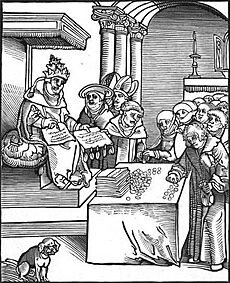
Protestant Christian groups reject the pope's claims of special honor, jurisdiction, and infallibility. Some believe the pope is the Antichrist mentioned in the Bible.
Historically, Protestants disagreed with the papacy's claim of political power over all governments. They also objected to the pope's relationship with empires and the pope's strong authority. These disagreements were a big part of the Protestant Reformation.
Antipopes
Sometimes, groups form around Antipopes. These are people who claim to be pope but were not properly elected. Traditionally, this term was for claimants with many cardinals or clergy supporting them. An antipope usually appears because of disagreements about beliefs or confusion over who the real pope is. In the 15th century, three different people claimed to be the rightful pope at one point.
Other Uses of the Title "Pope"
In early Christianity, the title "Pope" (meaning "father") was used by all bishops. Eventually, it became mainly linked to the bishop of Rome. In some cases, the term is used for other Christian leaders. In English, Catholic priests are called "father," but "pope" is only for the head of the Catholic Church.
In the Catholic Church
"Black Pope" is a popular, unofficial name for the leader of the Jesuits. This name comes from the black color of his clothes. It suggests a comparison to the "White Pope" (the actual pope, who wears white).
In the Eastern Churches
Since the 3rd century, the bishop of Alexandria in both the Coptic Orthodox Church and the Greek Orthodox Church of Alexandria is still called "pope." The Coptic leader is called "Coptic pope" or "Pope and Patriarch of All Africa." The Greek Orthodox leader is called "Pope and Patriarch of Alexandria and All Africa."
In some Orthodox churches, like the Bulgarian Orthodox Church and Russian Orthodox Church, a village priest might be called a "pope" (pop). This is different from the word used for the head of the Catholic Church (papa).
In New Religious Movements
Some new Christian groups, especially those separate from the Catholic Church but keeping a similar structure, use "pope" for their leader. Examples include the African Legio Maria Church and the European Palmarian Catholic Church. The Cao Dai, a Vietnamese faith, also has a pope.
Lengths of Papal Reigns
Longest-Reigning Popes
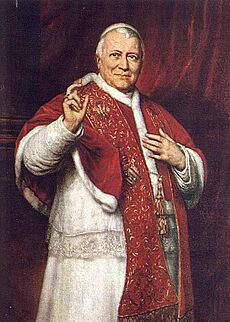
The popes with the longest reigns are:
- Saint Peter (around 30–64/68 AD): about 34 to 38 years.
- Bl. Pius IX (1846–1878): 31 years, 7 months, and 23 days.
- St. John Paul II (1978–2005): 26 years, 5 months, and 18 days.
- Leo XIII (1878–1903): 25 years, 5 months, and 1 day.
- Pius VI (1775–1799): 24 years, 6 months, and 15 days.
- Adrian I (772–795): 23 years, 10 months, and 25 days.
- Pius VII (1800–1823): 23 years, 5 months, and 7 days.
- Alexander III (1159–1181): 21 years, 11 months, and 24 days.
- St. Sylvester I (314–335): 21 years, 11 months, and 1 day.
- St. Leo I (440–461): 21 years, 1 month, and 13 days.
During the Western Schism, Avignon Pope Benedict XIII (1394–1423) reigned for over 28 years. But he is considered an anti-pope, so he is not on this list.
Shortest-Reigning Popes
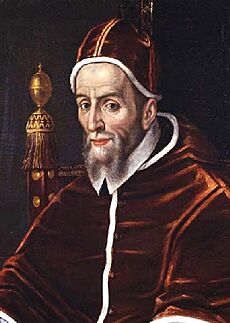
Several popes reigned for about a month or less. The number of days includes partial days.
- Urban VII (15–27 September 1590): 13 calendar days. He died before his coronation.
- Boniface VI (April 896): 16 calendar days.
- Celestine IV (25 October – 10 November 1241): 17 calendar days. He died before his coronation.
- Theodore II (December 897): 20 calendar days.
- Sisinnius (15 January – 4 February 708): 21 calendar days.
- Marcellus II (9 April – 1 May 1555): 23 calendar days.
- Damasus II (17 July – 9 August 1048): 24 calendar days.
- Pius III (22 September – 18 October 1503) and Leo XI (1–27 April 1605): both reigned for 27 calendar days.
- Benedict V (22 May – 23 June 964): 33 calendar days.
- John Paul I (26 August – 28 September 1978): 34 calendar days.
Stephen (23–26 March 752) died three days after his election. He died before becoming a bishop. He is not recognized as a valid pope.
The Annuario Pontificio does not give consecutive numbers to popes. It says it is hard to know who was the rightful pope at certain times. This is especially true for Pope Leo VIII, Pope Benedict V, and some popes from the mid-11th century.
Images for kids
-
Gregory the Great (around 540–604), in a painting by Carlo Saraceni, around 1610, Rome
-
A map of the Mediterranean states in 1400. The Western Schism lasted from 1378 to 1417.
-
As part of the Catholic Reformation, Pope Paul III (1534–1549) initiated the Council of Trent (1545–1563), which established the triumph of the papacy over those who sought to reconcile with Protestants or oppose papal claims.
-
A fresco of Eliakim in the Sistine Chapel, Vatican City
-
The Delivery of the Keys, by Pietro Perugino, 1481
-
The 1417 conclave in Konstanz where Pope Martin V was elected
-
The formal declaration of "Habemus Papam" after the election of Pope Martin V
-
The funeral of Pope John Paul II at the Vatican in April 2005, presided over by Cardinal Joseph Ratzinger, the future Pope Benedict XVI
-
The signature of Pope Francis during his pontificate
-
The signature of Pope Leo XIV during his pontificate
-
Entrance to Vatican City, with inscription "Benedictus XVI Pont(ifex) Max(imus) Anno Domini MMV Pont(ificatus) I.", i.e., "Benedict XVI, Pontifex Maximus, in the year of Our Lord 2005, the first year of his pontificate."
-
Pope Pius XII, wearing the traditional 1877 Papal tiara, is carried through St. Peter's Basilica on a sedia gestatoria; around 1955.
-
Antichristus, a woodcut by Lucas Cranach the Elder of the pope using the temporal power to grant authority to a generously contributing ruler
-
Pope Pius VII, bishop of Rome (seated), and Cardinal Giovanni Battista Caprara
-
Antichristus, by Lucas Cranach the Elder, from Luther's 1521 Passionary of the Christ and Antichrist. The pope is signing and selling indulgences.
-
Pope Pius IX, the pope with the longest verifiable reign
-
Pope Urban VII, the shortest-reigning pope
See also
 In Spanish: Papa para niños
In Spanish: Papa para niños


